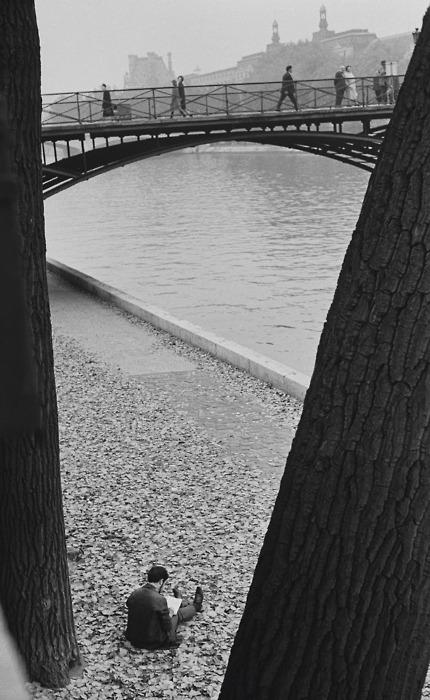Something untoward had been going on – there no longer seemed to be any question about that. But I thought perhaps I could make up for the past by plunging forward to some photographs of the bridge dated much later than the three I had so far inspected. The problem is that in photography there is no forward, just as there is no backward. Photographs are anchored in an eternal instant where redemption is ipso facto impossible, as I discovered when I returned to Kertész’s catalog. As I said, I’d come across those trees before. If you take another look at them, you’ll see that behind the third of the six pictured trees you can just about make out a ghostly figure of hunched man. It seems ridiculous, I know. At first even I could scarcely credit it. I wrote it off as an illusion, a mere trick of light, until I turned over the page to this, a photograph of the Pont des Arts taken by Kertész hunched down between two grand, angular lindens.
In 1894, the art critic Félix Fénéon was arrested on charges of terrorism. When the case came to trial, the judge put it to Fénéon that he had been seen talking to a known anarchist behind a lamppost. “Can you tell me, Monsieur le Président,” Fénéon replied, “which side of a lamppost is its behind?” A judicious wisecrack, to be sure. A lamppost does not have a back, just as it does not have a front. The same would be true of a column, a street pole or indeed a tree. To be behind a tree implies some intention of stealth; it is related less to the subject’s physical position than to his psychological condition. ‘Behind’ is a tricky preposition, I accept that. But there can be no mistake about this: Kertész took this photo from behind those linden trees.
If the figure of Kertész haunts the Atget photograph, it is the absence of Atget that haunts Kertész’s reply. Atget was careful to leave as few traces as possible. Perhaps he managed to escape the ongoing moment of the series. Perhaps he is simply obscured by one of the trees. Either way, it is at this point that he seems to bow out of the project. As far as I can tell, Atget played no further part in the plot.
What was more pressing to me was the whereabouts of the hitherto unseen subject of these shots. Was it possible that he’d been present all along? I suppose he could have been the painter on the bridge. He could also have been the man sitting on the riverbank writing (what is he writing? I wonder). He could quite simply have been one of the melancholic figures crossing the bridge in apparent anonymity. ‘He’ could even have been ‘she’. Surely not, though. I stared into the photograph at such length and in such depth that at times it lost all meaning, resembling nothing so much as a series of abstract shapes and textures. I could not believe the true subject had appeared yet. But now I found myself in the luckless position of hoping – for the sake of my own mental health – that this abhorrent surveillance operation had come to a successful, plain and published conclusion. How else could I ever hope to sleep soundly again?
